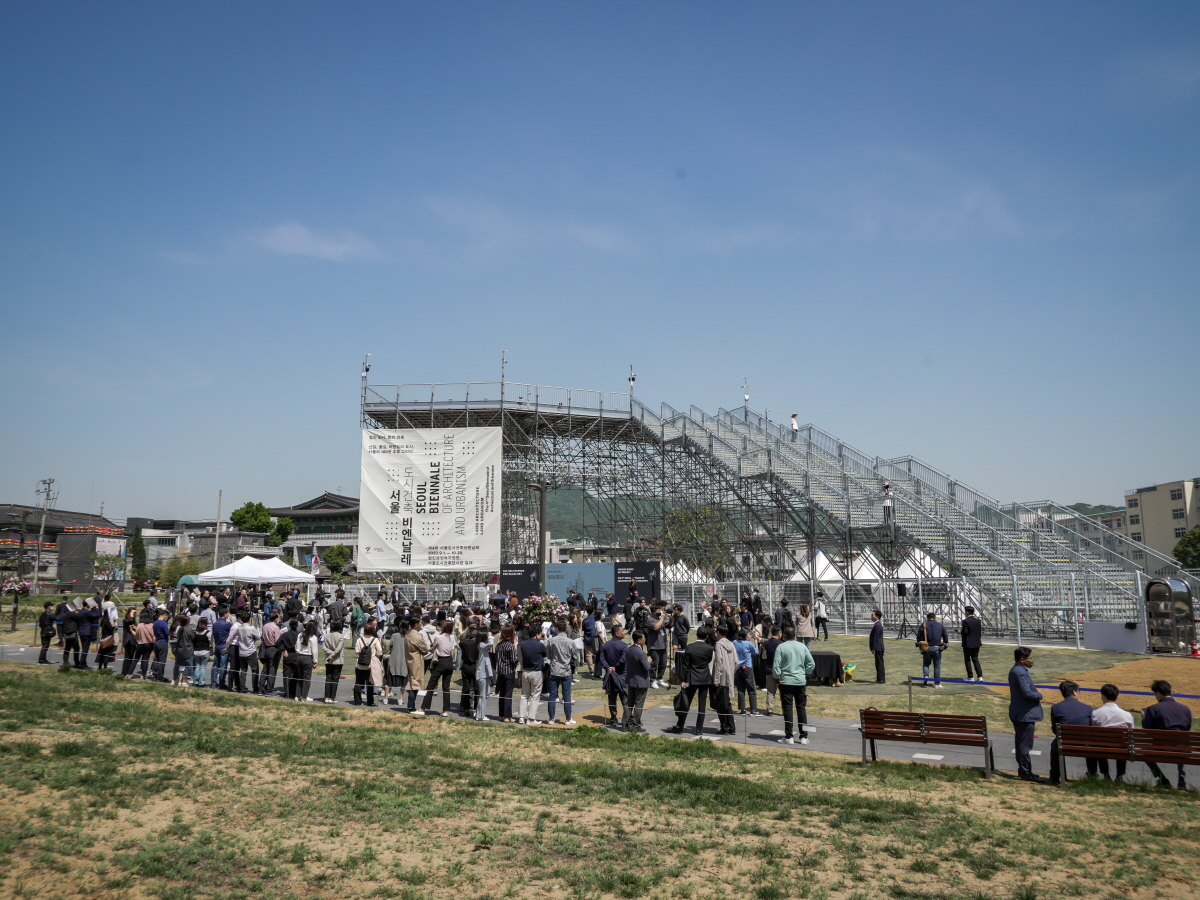SPACE June 2023 (No. 667)
 Image courtesy of Seoul Metropolitan Government
Image courtesy of Seoul Metropolitan Government
The Sky Pavilion of the 2023 Seoul Biennale of Architecture and Urbanism (hereinafter Seoul Biennale) opened on Apr. 3. Sky Pavilion, meaning a point that meets the sky, is an observatory-shaped sculpture installed in the open Songhyeon Green Plaza (hereinafter Songhyeon Plaza). Climbing the 12m tall Sky Pavilion, you can see Gyeongbokgung Palace, Inwangsan Mountain, Bukhansan Mountain, and the nearby city centre at a glance. It has been designed so that visitors can experience the past, present, and future of Seoul at once, while climbing the stairs of the pavilion, from the ground to the sky.
Sky Pavilion is a structure that subtly interrogates the theme of the Seoul Biennale, ‘Land Architecture, Land Urbanism’, led by the general director Cho Byoungsoo (principal, BCHO Partners). Hanyang, an ancient city of Seoul, was an eco-friendly city planned along the flow of mountains, rivers and wind. However, in the process of transforming into a modern city, the natural environment, the identity of Seoul, was greatly damaged. From this standpoint, this year’s biennale seeks ways of recovering this lost land, presenting a direction ahead for future cities. The Biennale consists of five sections: a thematic exhibition introducing discourses and projects on the architecture of the land; the Seoul 100-year masterplan exhibition exploring a future Seoul through data studies and advanced technology; a guest cities exhibition that examines the political, legal, and administrative background; an on-site project to experience the theme through a pavilion; and global studios prepared as forums for discussion between architecture students from around the world. In addition to the general director, Chun Euiyoung (professor, Gyeonggi University), Lim Jinyoung (principal, OPENHOUSE Seoul), Youm Sanghoon (professor, Yonsei University), Kim Sara (principal, Diagonal Thoughts), and Leif Høgfeldt Hansen (professor, Aarhus School of Architecture) all participated as section curators. If past biennales explored the future of Seoul through models and the critical discourses emerging from scrutiny of cities around the world, in line with the themes of each conference, such as ‘Imminent Commons’ in 2017, ‘Collective City’ in 2019, and ‘Crossroads, Building the Resilient City’ in 2021, this biennale is different in that it uses Seoul as a target of exploration from which to derive a theme and build new discussion. The biennale is held at the Seoul Hall of Urbanism & Architecture and areas near Seoul Citizens Hall, and the Songhyeon Plaza. In particular, Songhyeon Plaza, closed for a period surrounded by a 4m-high fence and only recently reopened to the public last October, is used as the main exhibition hall. In this biennale, as an extension of the theme of ‘Land Architecture, Land Urbanism’, various experience-oriented programmes will be presented to explore the sense of place of Songhyeon Plaza. Several architectural devices that inform this site, including the installation of Earth Pavilion, which can sense the energy of the earth, will be installed following the first Sky Pavilion. The Sky Pavilion will be used as an observatory and a resting place until the start of the biennale, and then will be reborn as an exhibition space for thematic exhibitions to view works exhibited in the biennale. The Seoul Biennale, which attends to the multi-layered problems of the present city of Seoul, seeking ways of moving towards a future city in which the land and natural elements are restored, will be open from Sep. 1 to Oct. 29. by Kim Jia





